
Glossop is a market town in the Borough of High Peak, Derbyshire, England. It is located 15 miles (24 km) east of Manchester, 24 miles (39 km) north-west of Sheffield and 32 miles (51 km) north of the county town, Matlock. Glossop lies near Derbyshire's borders with Cheshire, Greater Manchester, South Yorkshire and West Yorkshire. It is between 150 and 300 metres above sea level and is bounded by the Peak District National Park to the south, east and north.

Ranmoor is a suburb of the City of Sheffield, England. It is an affluent suburb in the Fulwood ward of the city. It mostly developed in the late 19th and early 20th centuries, and it features a number of large houses that were built for the city's steel magnates, as well as, most notably, a large church, St John's. This church was opened 24 April 1879 but was almost entirely destroyed by fire on 2 January 1887. All that survived from the original church was the tower and spire, which still stands today. A new building was built and the church reopened on 9 September 1888; it is now a Grade II* listed building. A row of early 19th century buildings near the church includes the Bull's Head and Ranmoor Inn public houses.
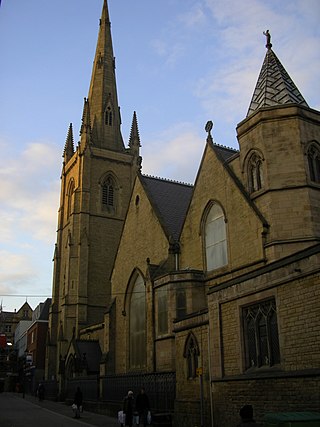
The Diocese of Hallam is a Latin Church ecclesiastical territory or diocese of the Catholic Church in England. The diocese comprises the whole of the City of Sheffield, and the surrounding towns of Rotherham, Doncaster, Barnsley, Chesterfield, the Peak District and areas of Worksop and Retford. It is a suffragan diocese in the ecclesiastical province of the metropolitan Archdiocese of Liverpool.
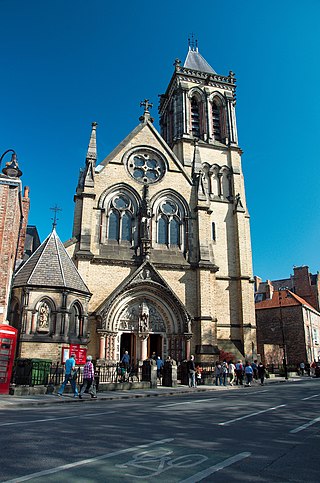
George Goldie was an English ecclesiastical architect who specialised in Roman Catholic churches.

St Paul's Church, Sheffield, was a chapel of ease to Sheffield Parish Church.
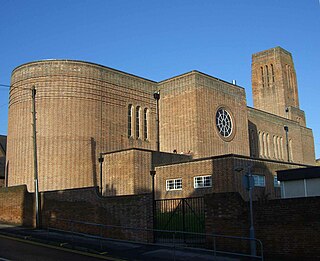
Sacred Heart Church is located in Forbes Road in the Hillsborough district of the city of Sheffield, South Yorkshire, England at grid reference SK333894. It is a Roman Catholic church in the Diocese of Hallam and is a Grade II listed building. The church is situated in an elevated position and its tower is a prominent landmark in the area.
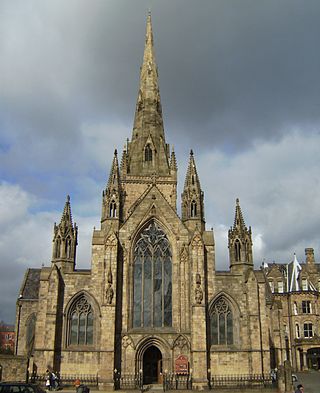
Matthew Ellison Hadfield was an English architect of the Victorian Gothic revival. He is chiefly known for his work on Roman Catholic churches, including the cathedral churches of Salford and Sheffield.
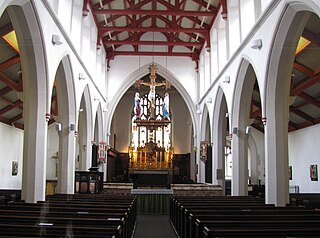
St Matthew's Church, more usually known as St Matthew's Carver Street, is situated on Carver Street in the centre of Sheffield, South Yorkshire, England. It is a Grade II listed building located at grid reference SK351871. The church is part of the Anglo-Catholic movement.

The Old Church of St. Peter is a Roman Catholic church established under the authority of the Roman Catholic Archdiocese of New York in Poughkeepsie, Dutchess County, New York in 1837. It is the second oldest Catholic Church on the Hudson and is considered the Mother Church of the Hudson Valley because from it all the parishes in Ulster and Dutchess counties were founded. The church is also referred to as Our Lady of Mount Carmel since 1965 when St. Peter's parish relocated to Hyde Park, New York and the parish of Our Lady of Mount Carmel church relocated to site.

St Michael's Cemetery is a Catholic burial ground in the Rivelin Valley area of Sheffield, South Yorkshire, England. The cemetery stands on a steep hillside on the south side of Rivelin Valley Road at its junction with Rivelin Road and Hollins Lane.
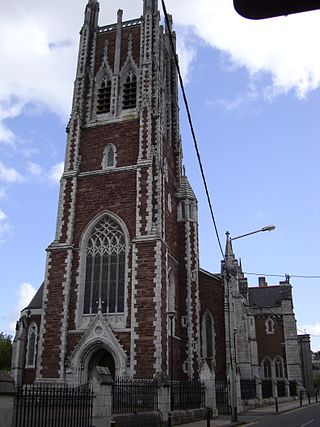
The Cathedral of Saint Mary and Saint Anne, also known as Saint Mary's Cathedral, The North Cathedral or The North Chapel, is a Roman Catholic cathedral located at the top of Shandon Street in Cork, Ireland. It is the seat of the Bishop of Cork and Ross, and the mother church of the Roman Catholic Diocese of Cork and Ross. Its name derived from the fact that it encompassed the ecclesiastical parish of St. Mary and the civil parish of St. Anne.

35 Well Meadow Street is the site of a house, attached workshops, courtyard complex and a crucible furnace. It is located in the St Vincent's Quarter of the City of Sheffield in England, it is also part of the Well Meadow Conservation Area. The buildings and furnace are grade II* listed buildings because of their importance as part of Sheffield’s industrial heritage and it is regarded as, “One of the most significant of the city’s 19th century industrial monuments”. It has now been converted into residences.

Burnley, in Lancashire, England, has a long history of religious worship, dating from at least before 1122 in the case of the Church of England. The chapel at Towneley Hall was the centre for Roman Catholic worship in Burnley until modern times. Well before the Industrial Revolution, the town saw the emergence of many non-conformist churches and chapels. In 1891 the town was the location of the meeting which saw the creation of the Baptist Union of Great Britain and Ireland. In the late 19th century a Jewish synagogue was established, and in recent times evangelical and free churches have appeared, as well as a large purpose-built mosque.
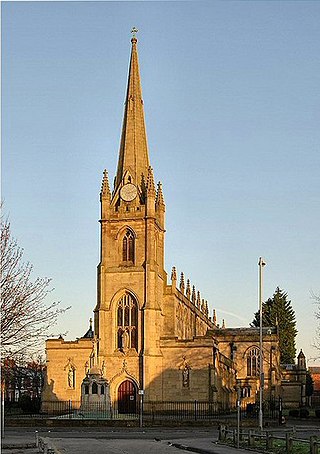
The Syro-Malabar Cathedral of St Alphonsa also known as St Ignatius Church is a Catholic cathedral of the Syro-Malabar rite in Preston, Lancashire. It is the cathedral of the Syro-Malabar Catholic Eparchy of Great Britain, and was previously under the Diocese of Lancaster. It is situated close to the Preston city centre, with the entrance on Meadow Street. The building was opened in 1836 and was the first church in Preston to have a spire.

The Monastery of The Holy Spirit, known locally as Kirk Edge Convent is a Carmelite monastery for nuns. It is situated on Kirk Edge Road between the villages of Worrall and High Bradfield within the boundaries of the City of Sheffield, England. It is one of 18 carmels in the United Kingdom. The building stands just within the Peak District at a height of 340 metres and has extensive views of the surrounding area.

St Cuthbert's Church is a Roman Catholic parish church in Durham, England. It was opened on 31 May 1827 to replace two previous chapels, one run by the secular clergy and the other by the Jesuits. It is also the home of the Durham University Catholic Chaplaincy and Catholic Society. From 2012 to 2016 the parish was entrusted, along with the chaplaincy, to the Dominican Order, and its congregation has since maintained the Dominicans' influence. The church is a protected building, being part of the Elvet Green Conservation Area. It is named for St Cuthbert of Lindisfarne, the 7th century bishop, healer and patron of Northern England.

St Joseph's Church is a Roman Catholic Parish church in Stockport, Greater Manchester, England. It was built from 1861 to 1862 and designed by Matthew Ellison Hadfield. It is situated on St Petersgate, south west of the High Street. It is the only church in England administered by the Priests of the Sacred Heart and is a Grade II listed building.

St Anne's Church is a Roman Catholic Parish church in Blackburn, Lancashire, England. It was founded in 1848, built in 1926 and designed by the architectural firm of Hill, Sandy & Norris of Manchester, who were also behind the construction of St John the Baptist Church in Rochdale.

St. Vincent de Paul Church is a historic parish church of the Roman Catholic Archdiocese of Chicago located in Chicago, Illinois. The parish was founded by the Vincentians in 1875. It is affiliated with DePaul University.

St Mary's Church is a Roman Catholic parish church in Stockton-on-Tees. It was built in 1842 and designed by Augustus Pugin in the Gothic Revival style. According to Historic England, the current building was first permanent Roman Catholic church to be built in Teesside since the Reformation. It is located in the town centre, on the corner of Norton Road and Major Street, with the A1305 road to the north of it. It is a Grade II listed building.





















